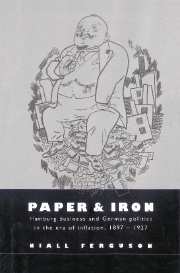- 中图分类号: K5
- 语种: ENG
- 出版信息: Cambridge University Press 1995 555页
- EISBN: 9780511886072
- PISBN-P: 9780521894227
- PISBN-H:9780521470162
- 原文访问地址:
KG评星
知识图谱评星,是一种基于用户使用的评价体系,综合图书的评论数量、引文数量、Amazon评分以及图谱网络中节点的PageRank值(即考虑相邻节点数量和重要性)等多种因素计算而得出的评价数值。星级越高,推荐值越高。CAT核心级
核心学术资源(CAR)项目作为教图公司推出的一项知识型服务,旨在打造一套科学、有效的图书评价体系,并协助用户制定相应的馆藏建设方案。CAR项目调查和分析12所世界一流大学的藏书数据,以收藏学校的数量确定书目的核心级,核心级越高,代表书目的馆藏价值越高。选取核心级在三级以上,即三校以上共藏的图书作为核心书目(CAT)。Few economic events have had a more profound or enduring impact than the German hyperinflation of 1923, still remembered popularly as a root cause of Hitler's rise to power. Yet many historians have argued that inflationary policies were, on balance, advantageous to post-1918 Germany, both boosting growth and helping to reduce reparations. The scholarly consensus is that there was no viable alternative to inflation. In Paper and Iron Niall Ferguson takes a different view. He argues that inflation was indeed an economic and political disaster, and further that there were alternative economic policies which could have stabilised the German currency in 1920. To explain why these were not adopted he points to long-term defects in the political institutions of the Reich which went back as far as the 1890s and which persisted beyond 1918. The book therefore reveals the Wilhelmine origins of Weimar's failure, as well as casting light on the origins of the Third Reich.







 京公网安备 11010602104826号
京公网安备 11010602104826号
